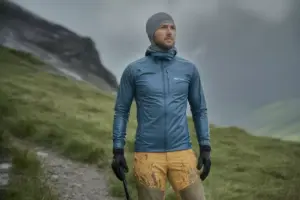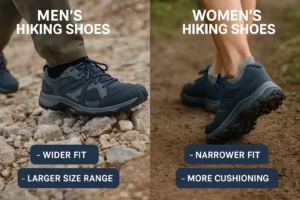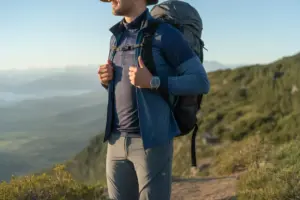Best Hybrid Hiking & Trail Running Shoes for Speed and Comfort on the Trail
Picture this: you’re on a challenging trail that starts with rocky terrain, transitions to muddy forest paths, and ends with a steep climb over loose gravel. Traditional hiking boots would slow you down, while lightweight running shoes might leave your feet bruised and unstable. This is where hybrid hiking and trail running shoes shine – offering the perfect balance of protection, comfort, and speed for modern outdoor enthusiasts.
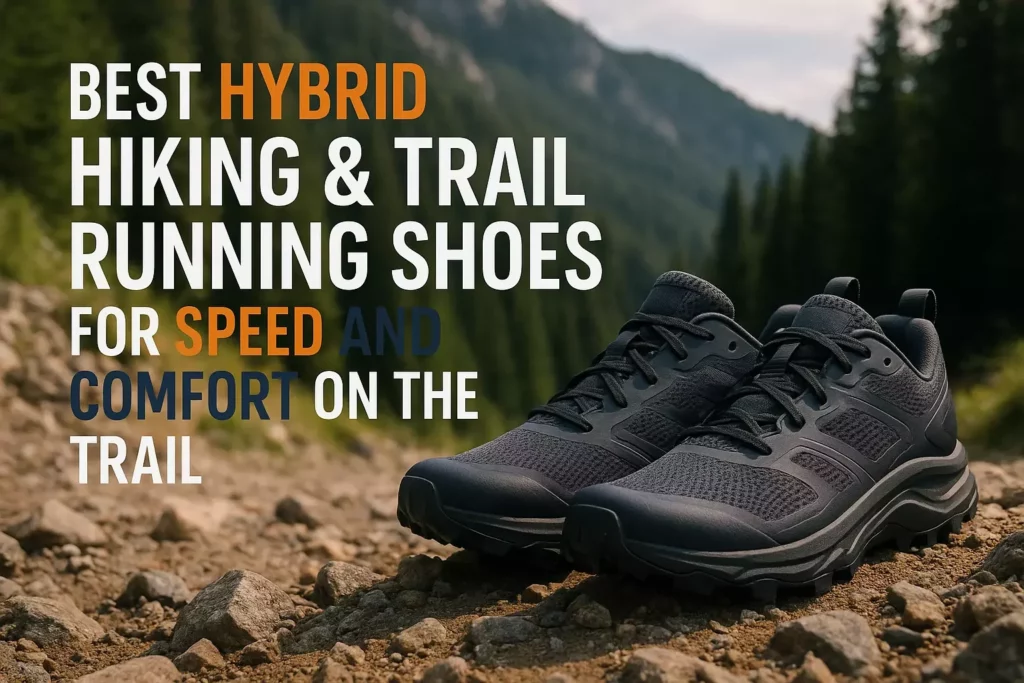
The outdoor gear industry has witnessed a revolutionary shift in recent years, with hybrid footwear becoming the go-to choice for adventurers who refuse to compromise between speed and safety. These innovative shoes combine the protective features of hiking boots with the lightweight agility of trail runners, creating the ultimate footwear solution for diverse terrain.
Key Takeaways
- Versatility is King: Hybrid shoes excel on mixed terrain, eliminating the need to choose between hiking boots and trail runners
- Weight Matters: Look for shoes under 12 ounces per shoe for optimal speed without sacrificing essential protection
- Fit is Everything: Proper sizing with thumb-width space prevents blisters and ensures comfort during long adventures
- Terrain-Specific Features: Match shoe characteristics (grip patterns, cushioning, protection) to your most common trail conditions
- Break-in Period: Even the best hybrid shoes need 20-30 miles of gradual use before tackling challenging terrain
What Makes Hybrid Hiking & Trail Running Shoes Special?
Hybrid shoes represent the evolution of outdoor footwear, designed for athletes and adventurers who demand versatility. Unlike traditional hiking boots that prioritize protection over speed, or trail runners that focus on lightweight performance, hybrid shoes masterfully balance both worlds.
Key characteristics include:
- Moderate ankle support without the bulk of high-top boots
- Lightweight construction typically weighing 8-12 ounces per shoe
- Aggressive tread patterns for multi-terrain traction
- Protective toe caps and heel counters for rock and root protection
- Breathable yet durable materials for comfort and longevity
The beauty of hybrid footwear lies in its adaptability. Whether you’re tackling a technical scramble, cruising through forest trails, or navigating stream crossings, these shoes provide the confidence to move quickly while maintaining the protection needed for challenging terrain.
Essential Features to Look For
🏃♂️ Weight and Construction
The ideal hybrid shoe strikes a delicate balance between protection and weight. Look for shoes weighing between 8-12 ounces per shoe. Anything lighter may sacrifice durability, while heavier options defeat the purpose of speed-oriented design.
Construction elements to prioritize:
- Seamless or minimal-seam uppers to reduce hot spots
- Reinforced high-wear areas without excessive bulk
- Flexible midsole that doesn’t restrict natural foot movement
🦶 Fit and Comfort
Proper fit is non-negotiable when covering long distances at speed. Your hybrid shoes should feel secure without being restrictive, with enough room to accommodate foot swelling during extended activities.
Fit checklist:
- Thumb-width space between longest toe and shoe front
- Snug heel with no slipping
- Comfortable width without pinching
- Room for toe movement when going downhill
For optimal comfort during extended outdoor adventures, consider how your footwear choice integrates with your overall gear selection, much like when packing your backpack for camping where every item must work harmoniously together.
🏔️ Traction and Grip
The outsole is where hybrid shoes truly prove their worth. Look for aggressive lug patterns with varying depths and shapes to handle different terrain types effectively.
Traction features to evaluate:
- Multi-directional lugs for climbing and descending
- Sticky rubber compounds for rock adhesion
- Self-cleaning tread patterns that shed mud and debris
- Heel and toe climbing zones for technical terrain
🛡️ Protection and Durability
While lighter than traditional hiking boots, hybrid shoes must still protect your feet from trail hazards.
Protection elements:
- Rock plates or stone guards in the forefoot
- Reinforced toe caps for impact protection
- Heel counters for stability on uneven terrain
- Gusseted tongues to keep debris out
Top Hybrid Shoe Categories
Lightweight Trail Crushers
These shoes prioritize speed and agility while maintaining essential protection. Perfect for well-maintained trails and fast-packing adventures.
Characteristics:
- Weight: 8-10 ounces per shoe
- Minimal ankle support
- Excellent breathability
- Responsive cushioning
All-Terrain Workhorses
The sweet spot for most outdoor enthusiasts, offering balanced protection and performance across diverse terrain.
Characteristics:
- Weight: 10-12 ounces per shoe
- Moderate protection features
- Versatile traction patterns
- Durable construction
Technical Terrain Specialists
Designed for challenging routes with significant rock, scree, or technical sections requiring maximum protection.
Characteristics:
- Weight: 11-13 ounces per shoe
- Enhanced protection features
- Aggressive traction patterns
- Superior stability systems
Sizing and Fit Guide
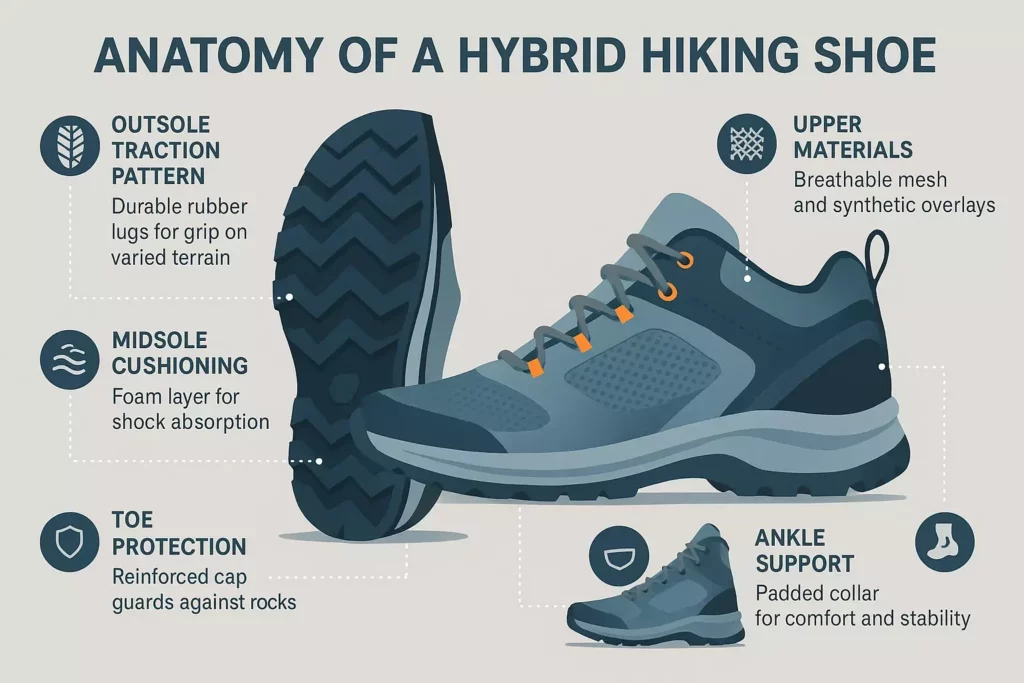
Getting the right fit is crucial for performance and injury prevention. Hybrid shoes should fit differently than everyday sneakers, accounting for the demands of trail activities.
Measuring Your Feet
Best practices:
- Measure in the afternoon when feet are naturally swollen
- Wear your typical hiking socks during fitting
- Measure both feet and size for the larger foot
- Consider seasonal variations in foot size
The Perfect Fit Formula
- Length: Thumb-width space from longest toe to shoe end
- Width: Snug but not tight, with no pinching
- Heel: Secure with minimal movement
- Arch: Supportive contact without pressure points
Common Fit Mistakes
❌ Sizing too small leads to black toenails and blisters
❌ Ignoring width causes lateral foot pain
❌ Overlooking sock thickness affects overall fit
❌ Not testing on inclines misses downhill fit issues
Terrain-Specific Recommendations
Rocky and Technical Terrain
For challenging terrain with loose rock, roots, and technical sections, prioritize protection and stability.
Key features:
- Rock plates for underfoot protection
- Aggressive heel and toe lugs
- Reinforced uppers
- Stable heel counters
Forest and Soft Trail Conditions
Trails with dirt, pine needles, and moderate obstacles benefit from balanced hybrid designs.
Key features:
- Moderate cushioning
- Self-cleaning tread patterns
- Breathable uppers
- Flexible construction
Mixed Terrain Adventures
For routes combining multiple terrain types, versatility trumps specialization.
Key features:
- Multi-directional traction
- Balanced protection
- Adaptable cushioning
- Durable construction
When planning mixed-terrain adventures, proper preparation extends beyond footwear. Consider essential safety items like those found in a well-stocked first aid kit to handle any trail mishaps.
Care and Maintenance Tips
Proper care extends the life of your hybrid shoes and maintains their performance characteristics.
Regular Cleaning
After each use:
- Remove loose dirt and debris
- Rinse with clean water if muddy
- Stuff with newspaper to maintain shape while drying
- Air dry away from direct heat
Deep Cleaning Process
Weekly or bi-weekly:
- Remove insoles and laces
- Scrub with soft brush and mild soap
- Rinse thoroughly
- Apply appropriate waterproofing treatment
- Allow complete drying before storage
Storage Best Practices
- Store in cool, dry location
- Avoid extreme temperatures
- Use cedar shoe trees for shape retention
- Rotate between multiple pairs when possible
When to Replace
Watch for these signs:
- Worn tread patterns affecting traction
- Compressed midsole cushioning
- Upper material breakdown
- Persistent odors despite cleaning
- Uneven wear patterns indicating gait issues
Breaking In Your New Shoes
Even the best-fitting hybrid shoes require a proper break-in period to achieve optimal comfort and performance.
Week 1: Easy Introduction
- 2-3 short walks on familiar terrain
- 30-45 minutes per session
- Focus on fit assessment and hot spot identification
Week 2: Building Confidence
- Longer walks up to 2 hours
- Introduce varied terrain gradually
- Test with full pack weight if applicable
Week 3: Trail Testing
- First trail adventures on moderate terrain
- Monitor foot comfort throughout activity
- Adjust lacing techniques as needed
Week 4: Full Deployment
- Tackle challenging terrain with confidence
- Extended adventures become comfortable
- Performance optimization through experience
Budget Considerations
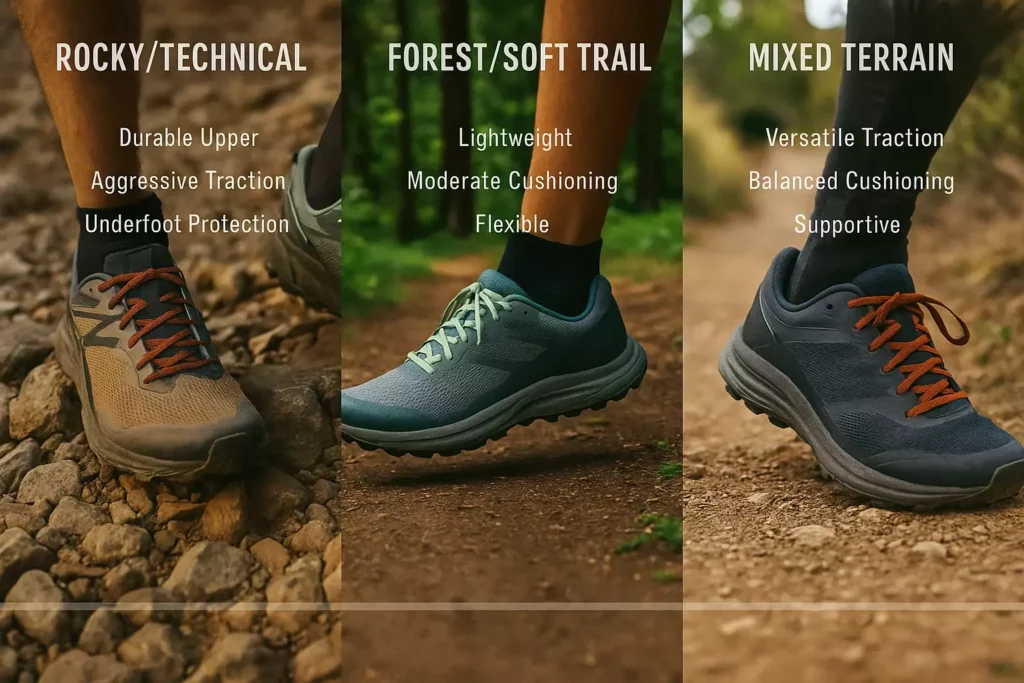
Hybrid hiking and trail running shoes span a wide price range, with options for every budget.
Entry Level ($60-$100)
Perfect for occasional trail users and beginners exploring the hybrid shoe concept.
What to expect:
- Basic protection features
- Adequate traction for moderate trails
- Shorter lifespan than premium options
- Good value for casual use
Mid-Range ($100-$160)
The sweet spot for most outdoor enthusiasts, offering excellent performance and durability.
What to expect:
- Advanced materials and construction
- Comprehensive protection features
- Extended durability
- Specialized terrain options
Premium ($160-$250)
Top-tier options for serious athletes and frequent trail users demanding maximum performance.
What to expect:
- Cutting-edge technology
- Superior materials and craftsmanship
- Specialized features for specific activities
- Maximum durability and performance
Value Optimization Tips
💡 Shop end-of-season sales for premium shoes at mid-range prices
💡 Consider previous year models with proven performance
💡 Factor in cost-per-mile over the shoe’s lifespan
💡 Invest in quality for frequent use scenarios
Common Mistakes to Avoid
Learning from others’ experiences can save time, money, and discomfort.
Sizing Errors
- Buying too small for fear of loose fit
- Ignoring width requirements for foot shape
- Not accounting for sock thickness during fitting
Feature Mismatches
- Over-protecting for easy terrain needs
- Under-protecting for challenging conditions
- Prioritizing style over functional requirements
Break-in Shortcuts
- Skipping gradual introduction leads to blisters
- Testing on challenging terrain too early
- Ignoring hot spots during initial wear
Maintenance Neglect
- Postponing cleaning reduces shoe lifespan
- Skipping waterproofing treatments
- Continuing use beyond replacement time
🥾 Find Your Perfect Hybrid Shoe
Weather and Seasonal Considerations
Different seasons and weather conditions demand specific features from your hybrid shoes.
Spring Trail Conditions
Spring brings unique challenges with mud, stream crossings, and variable weather.
Essential features:
- Quick-drying materials for wet conditions
- Aggressive tread for muddy terrain
- Gusseted tongues to keep debris out
- Moderate insulation for temperature swings
When preparing for spring adventures, consider how your footwear integrates with appropriate weather clothing to maintain comfort in changing conditions.
Summer Heat Management
Hot weather demands maximum breathability and moisture management.
Key considerations:
- Mesh panels for ventilation
- Moisture-wicking linings
- Light-colored uppers to reflect heat
- Minimal insulation to prevent overheating
Fall Versatility
Autumn conditions require adaptability as weather becomes unpredictable.
Important features:
- Water-resistant treatments for morning dew
- Reliable traction on wet leaves
- Moderate warmth for temperature drops
- Durable construction for increased activity
Winter Considerations
While hybrid shoes aren’t winter boots, some models handle mild winter conditions.
Winter-capable features:
- Insulated linings for warmth
- Water-resistant uppers
- Aggressive lugs for snow and ice
- Compatibility with microspikes
Advanced Performance Tips
Maximize your hybrid shoe performance with these expert techniques.
Lacing Strategies
Different lacing patterns optimize fit for various activities and foot shapes.
Heel Lock Technique:
- Lace normally to second-to-last eyelet
- Create small loops with laces
- Thread opposite lace through each loop
- Tighten and tie normally
Wide Foot Accommodation:
- Skip every other eyelet in problem areas
- Use parallel lacing instead of criss-cross
- Loosen mid-foot while maintaining heel security
Sock Selection
The right socks complement your hybrid shoes for optimal performance.
Material priorities:
- Merino wool for odor resistance and temperature regulation
- Synthetic blends for quick drying
- Avoid cotton which retains moisture
Fit considerations:
- Cushioning level matches intended use
- Height compatibility with shoe collar
- Seamless toe construction prevents hot spots
Foot Care Strategies
Proper foot care prevents issues and enhances performance.
Pre-activity preparation:
- Trim toenails appropriately
- Apply anti-chafing products to problem areas
- Ensure feet are clean and dry
During activity monitoring:
- Address hot spots immediately
- Adjust lacing as feet swell
- Take breaks to air out feet
For extended backcountry adventures, foot care becomes even more critical. Consider including foot care items in your survival kit for emergency situations.
Technology and Innovation Trends
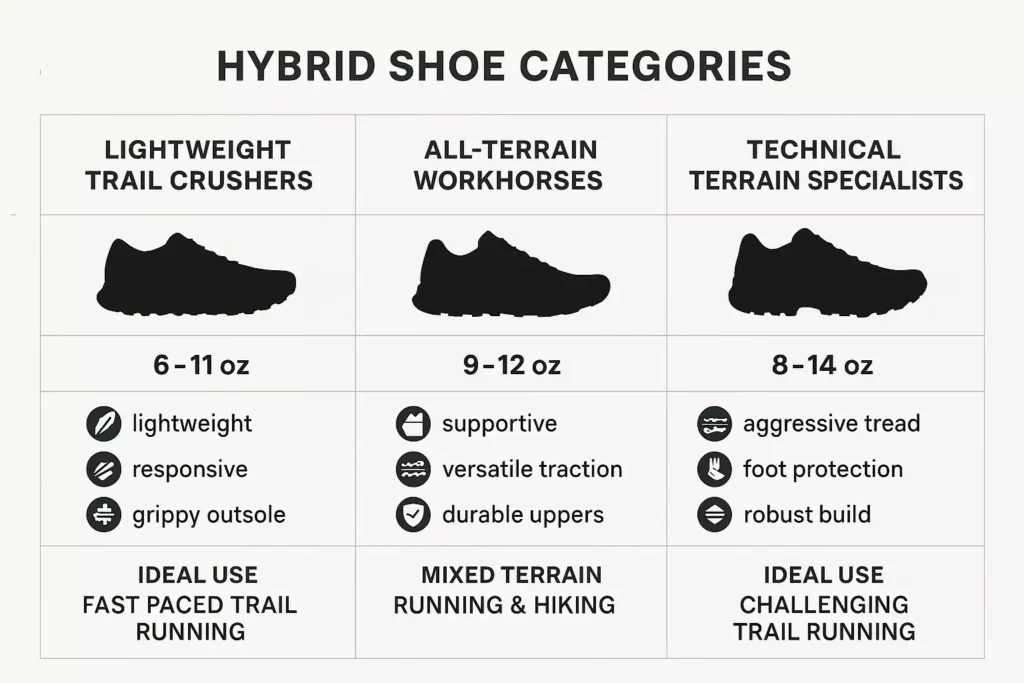
The hybrid shoe market continues evolving with exciting technological advances.
Material Innovations
Next-generation fabrics:
- Graphene-enhanced materials for strength and conductivity
- Bio-based synthetics for environmental sustainability
- Smart textiles that adapt to conditions
Midsole Technology
Advanced cushioning systems:
- Energy-return foams for efficiency
- Adaptive cushioning that adjusts to terrain
- Lightweight protection without bulk
Traction Advances
Outsole innovations:
- Compound-specific rubber for different terrain zones
- Self-adapting lugs that change with conditions
- Biomimetic patterns inspired by nature
Fit Technology
Precision fitting systems:
- 3D foot scanning for custom fit
- Adjustable components for personalization
- Pressure mapping for hot spot prevention
Environmental Impact and Sustainability
Modern outdoor enthusiasts increasingly consider the environmental impact of their gear choices.
Sustainable Materials
Eco-friendly options:
- Recycled plastics in uppers and laces
- Natural rubber compounds
- Organic cotton linings
- Water-based adhesives
Manufacturing Practices
Responsible production:
- Reduced water usage in manufacturing
- Renewable energy in facilities
- Local sourcing to reduce transportation
- Fair labor practices
End-of-Life Considerations
Disposal and recycling:
- Take-back programs from manufacturers
- Recyclable components where possible
- Donation options for usable shoes
- Proper disposal of non-recyclable parts
Longevity Focus
Maximizing shoe lifespan:
- Quality construction over disposable design
- Repairable components when possible
- Proper maintenance extends usability
- Multiple pair rotation reduces wear
Family and Group Considerations
When outfitting families or groups, additional factors come into play.
Kids’ Hybrid Shoes
Children’s feet and activity patterns require special consideration.
Key differences:
- Faster growth requires frequent replacement
- Higher activity levels demand durability
- Safety features become more important
- Easy on/off designs help independence
For families planning outdoor adventures, proper footwear selection integrates with overall family camping preparations to ensure everyone’s comfort and safety.
Group Gear Coordination
Planning considerations:
- Pace matching based on footwear capabilities
- Terrain compatibility for all skill levels
- Emergency preparedness for various scenarios
- Backup options for gear failures
Budget Management
Cost-effective strategies:
- Seasonal sales for bulk purchases
- Previous model discounts
- Quality focus over quantity
- Sharing information on deals and recommendations
Conclusion
Choosing the perfect hybrid hiking and trail running shoes requires balancing multiple factors: terrain demands, personal preferences, fit requirements, and performance goals. The key lies in understanding that there’s no universally “best” shoe – only the best shoe for your specific needs and adventures.
Your next steps:
- Assess your primary terrain and typical adventure distances
- Determine your priority between speed, protection, and comfort
- Get professionally fitted at a specialty outdoor retailer
- Start with a gradual break-in process before challenging adventures
- Maintain your investment with proper care and timely replacement
Remember that hybrid shoes represent a significant evolution in outdoor footwear, offering unprecedented versatility for modern adventurers. Whether you’re tackling technical scrambles, cruising forest trails, or embarking on multi-day adventures, the right hybrid shoes will enhance your performance while keeping your feet comfortable and protected.
The trail is calling – make sure you’re equipped with footwear that matches your ambition and keeps pace with your adventures. Your feet will thank you for the careful consideration, and your trail experiences will reach new levels of enjoyment and performance.



